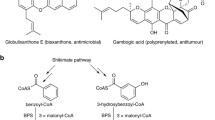Abstract.
A crucial step in plant xanthone biosynthesis is the cyclization of an intermediate benzophenone to a xanthone. In cultured cells of Centaurium erythraea RAFN, 2,3′,4,6-tetrahydroxybenzophenone (THBP) was shown to be intramolecularly coupled to 1,3,5-trihydroxyxanthone, whereas in cell cultures of Hypericum androsaemum L. it was coupled to form the isomeric 1,3,7-trihydroxyxanthone. These regioselective cyclizations that occur ortho and para, respectively, to the 3′-hydroxy group of the benzophenone depend on cytochrome P 450, as shown by the effectiveness of established P 450 inhibitors and blue-light-reversible carbon monoxide inhibition. Furthermore, the reactions absolutely require NADPH and O2. The underlying reaction mechanism is probably an oxidative phenol coupling that is catalyzed regioselectively by xanthone synthases. These enzymes are proposed to be cytochrome P 450 oxidases. The intramolecular cyclizations of THBP to 1,3,5- and 1,3,7-trihydroxyxanthones catalyzed by the two xanthone synthases represent an important branch point in the plant xanthone biosynthetic pathway.
Similar content being viewed by others
Author information
Authors and Affiliations
Additional information
Received: 24 March 1997 / Accepted: 28 May 1997
Rights and permissions
About this article
Cite this article
Peters, S., Schmidt, W. & Beerhues, L. Regioselective oxidative phenol couplings of 2,3′,4,6-tetrahydroxybenzophenone in cell cultures of Centaurium erythraea RAFN and Hypericum androsaemum L.. Planta 204, 64–69 (1997). https://doi.org/10.1007/s004250050230
Issue Date:
DOI: https://doi.org/10.1007/s004250050230



